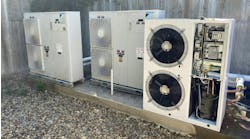WE BEGAN last month’s column (pg.32) exploring missed opportunities for heating domestic hot water. This month let’s look into the different types and styles.
The sizing of “side-arm” DHW units, as they are referred to in the industry, is based on numerous factors. The largest individual “dump load” that needs to be served usually dictates the size of the actual tank. In some of the custom homes I see, many of the homeowners are unhappy that they can’t fill their Olympic-sized whirlpool tub in one filling. There is obviously a weak link somewhere in the chain of command that dictates the DHW system.
The general contractor has the plumber do silly things like adding un-powered electric storage tanks in series with the gas-fired tank, hoping that the hot water will somehow migrate from the gas-fired tank to the non-powered electric storage tank.
When they realize that all they’ve done is incorporated a 40-gal. fat spot into the line, they come back and add a circulator and some other pipes to the system so that they can move the heat between the tanks. Now they end up with 80 gal. of lukewarm water, which has the capacity to fill the Olympic-sized bathtub – with lukewarm water – at times.
We, as diligent hydronic contractors, need to look at these homes in more detail and explain to the homeowners the need for the larger-capacity, faster-recovering water heater that we have to offer. Point out the simple fact that they won’t be able to fill their 70-gal. tub with a 40-gal. water heater, which is actually only capable of delivering 32 gal. of hot water to their tub. They’ll see the light.
As Dan Holohan has always said, “You want fries with that burger?” How are they going to know what you have to offer if you don’t tell them up front?
There are many different types of side-arm style DHW heaters. If the actual gallon-per-minute draw is limited, an instantaneous heat exchanger may be installed that has the capacity to convert 100% of the closed-loop boiler’s output in the form of a given degree Fahrenheit rise. These instantaneous-type heaters are generally limited in their scope and applications to situations where it is definitely known that only one appliance will be allowed to be used at any given time. Not likely on the American scene.
This type of instantaneous water heater may be as simple as a copper coil immersed in the top of a hot water boiler that is kept constantly hot (160°F minimum) or it may be a remote brazed-plate or similar type of heat exchanger where, again, the boiler must be maintained in a “ready” steady state of being hot.
These systems typically have a much higher standby loss for obvious reasons, and with recent increases in the basic costs of energy, we’re seeing less and less of them on the market.
Another type of side-arm DHW heater is the semi-instantaneous model. This is similar to the instantaneous model except that it has some storage capacity, which allows the boiler to be turned off during periods of non-use. When hot water is drawn, it is detected by a tank ‘stat and the boiler is fired up to its maximum firing capacity. This type of system is also extremely limited in its per-minute recovery and output capacity, and as long as only one point of hot water use is online at any given time, this system can provide a “nearly unlimited” supply of DHW.
This system doesn’t handle the large soaking-tub dump load demands well, unless the user is willing to wait up to 30 minutes or more to fill the tub.
The heat exchanger itself is usually steel or some other type of metal shell, which is loaded with numerous parallel circuits of copper tubing. Although it can have sufficient storage to handle large dump loads, they are typically sized to handle back-to-back showers or clothes washing loads.
Another type of side-arm DHW system is one where the storage tank has a large capacity, in some cases up to 119 gal., and a slower recovery capacity due to a smaller heat exchanger surface within the tank. While this type of tank is excellent at handling large dump loads, its slower recovery capacity limits its output during back-to-back-to-back showering or other similar loads.
One thing I learned early on in this business is that regardless of what the manufacturer’s literature says, you never want to tell customers that they will never run out of domestic hot water. You can say “should never” run out of hot water or, “You’ll have a nearly limitless supply of hot water.” But never ever tell them that they’ll never run out of hot water, because if you do, they will.
Pay particularly close attention to the manufacturer’s tank specification literature as it relates to boiler size. Just because you installed the company’s tank doesn’t mean it’s going to produce the gallons per hour that the literature quoted unless you provide the firepower the manufacturer specifies in the brochure.
Tune in next month when we discover the world of tankless hot water heating systems and their potential applications.
Until then, Happy Domestic Hot Water Hydronicing!
Mark Eatherton is a Denver-based hydronics contractor. He can be reached via e-mail at [email protected] or by phone at 303/778-7772.

